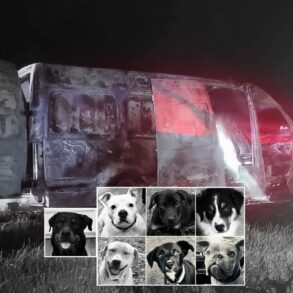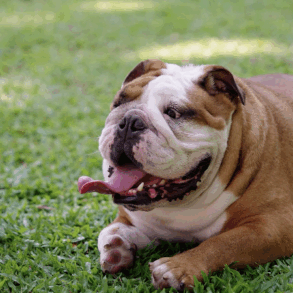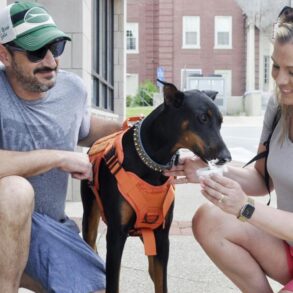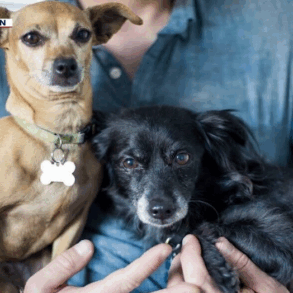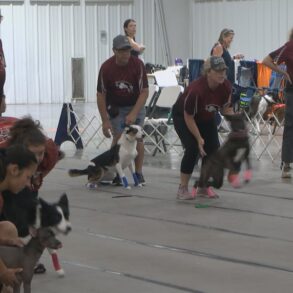Dogs could be undergoing a third wave of domestication driven by humans’ desire for pets that are friendly, calm and well-suited to a sedentary lifestyle.
Just decades ago, canines were seen as working animals, tasked with hunting pests, herding livestock and guarding their homes.
But today, companionship is a much higher priority for pet owners.
Scientists have found that this shift has increased levels of a hormone responsible for social bonding in dogs, and especially in service dogs.

A study concluded that the hormone – oxytocin – is what drives dogs to seek contact with their owners.
As humans domesticated wolves into the affectionate pets we know today, canines’ sensitivity to oxytocin increased, according to the researchers.
The study, conducted by researchers at Sweden’s Linköping University in 2017, investigated how dogs developed their unique ability to work together with humans, including their willingness to ‘ask for help’ when faced with a difficult problem.
The researchers suspected that the hormone oxytocin was involved, as it is known to play a role in social relationships between individuals.
The effect of oxytocin depends on how well it binds to its receptor inside cells.
Previous studies have shown that variations in genetic material located close to the gene that codes for oxytocin receptors influences dogs’ ability to communicate.
In other words, a dog’s social skills are partially ingrained in their genetics – specifically to the genes that control their sensitivity to oxytocin.
The researchers observed 60 golden retrievers as they attempted to lift a lid off a jar of treats, which was intentionally made impossible to open.
They also collected DNA swabs from inside the dogs’ noses to determine which variant of the oxytocin receptor each one had.

The dogs performed this behavioral test twice, once after receiving a dose of oxytocin nasal spray, and once after receiving a dose of neutral saline nasal spray.
The team timed the dogs to see how long they would attempt to open the jar themselves before turning to their owner to ask for help.
The results showed that dogs with a particular genetic variant of the receptor had a stronger reaction to the oxytocin spray than other dogs, and that the oxytocin dose made them more likely to ask for help than the saline dose.
These findings offer insight into how domestication has altered the genes that influence dogs’ social skills.
Now, canine experts Brian Hare and Vanessa Woods saiddogs’ behavioral traits are undergoing a third wave of domestication.
As the role that these animals play in our lives has shifted from worker to companion, so has their behavior, and perhaps their biology too.
Hare is an evolutionary-anthropology professor at Duke University and the director of the Duke Canine Cognition Center. Woods manages the center’s Puppy Kindergarten program, which trains pups to become service dogs.
The Puppy Kindergarten also serves as a long-term research project to assess how different training strategies impact dogs’ behavior and cognitive development.
Studying these puppies has convinced Woods and Hare that service dogs are ‘uniquely well adapted to life in the 21st century,’ they wrote in The Atlantic.
These dogs are ‘highly trained professionals’ who can assist their owner with tasks, remain calm and quiet when not actively working, and have uniquely friendly dispositions.
‘Unlike most pet dogs, service dogs are attracted to strangers, even as puppies,’ Woods and Hare wrote.
‘And increasing friendliness seems to have changed these dogs’ biology, just as it did thousands of years ago,’ the researchers added.
These highly trained dogs embody the traits of the ideal canine companion. They fit seamlessly into the lives of their owners and into the modern world.
‘Service dogs fit into the life of their person in a way that many able-bodied dog owners want their pets to fit into theirs,’ Woods and Hare wrote.
Even just a few decades ago, dogs were viewed very differently than they are today. They were working animals tasked with jobs like hunting, herding and guarding their home and the people in it – conditioned to be active and on alert.
Up until the 1990s, dogs spent most of their lives outside. Without the sprawling urbanization we know today, they had plenty of space to roam and explore.
‘If your dog slept on your bed, you would likely wake up covered in ticks or fleas,’ the researchers wrote.

But today, more dogs live in densely populated areas, and consequently spend a lot more time inside. They also interact with unfamiliar dogs and people more frequently.
This shift has caused some behaviors that made dogs appealing to our ancestors to become maladaptive, Woods and Hare wrote. For example, ‘guarding against strange people and animals might make a dog more difficult to walk around the neighborhood.’
‘Dogs that are more energetic, excitable, fearful, or anxious than average are more likely to be relinquished to shelters, where they may struggle to find a new home,’ they added.
Woods and Hare believe that these new societal pressures are driving a third wave of canine domestication, with service dogs representing the most highly evolved members of the pack.
‘Service dogs may look like your average Labrador retriever, but compared with military working dogs or even the average family Lab, they are almost a different breed,’ the researchers wrote.
‘The differences between Canine Companion dogs and pet dogs also demonstrate how different a population of dogs can become in less than 50 years,’ they added.
Canine domestication dates back between 40,000 and 14,000 years. The first wave of domestication began when humans lived as foragers, and often left food waste on the outskirts of their settlements.
Wolves that took advantage of this predictable, energy-rich food source gained a survival edge, Woods and Hare say. ‘As a result, over generations, the animals’ attraction to humans replaced fear and aggression.’
The second wave began after the Industrial Revolution. During this time, the rising middle class wanted dogs that represented the good taste and disposable income of their owners.
This prompted Westerners to begin breeding dogs for specific physical traits, ultimately creating most of the 200 dog breeds recognized by the American Kennel Club today, the researchers wrote.
As we enter a third wave of domestication – one that is more focused on tailoring dogs’ personalities to our modern world – Woods and Hare believe that humans should take an active role in facilitating this process.
‘For the happiness of dogs and their owners, humans need to breed and train more dogs like service animals, embarking on a new wave of dog domestication to help them fit into the new world we have created,’ they wrote.
This post was originally published on this site be sure to check out more of their content.












